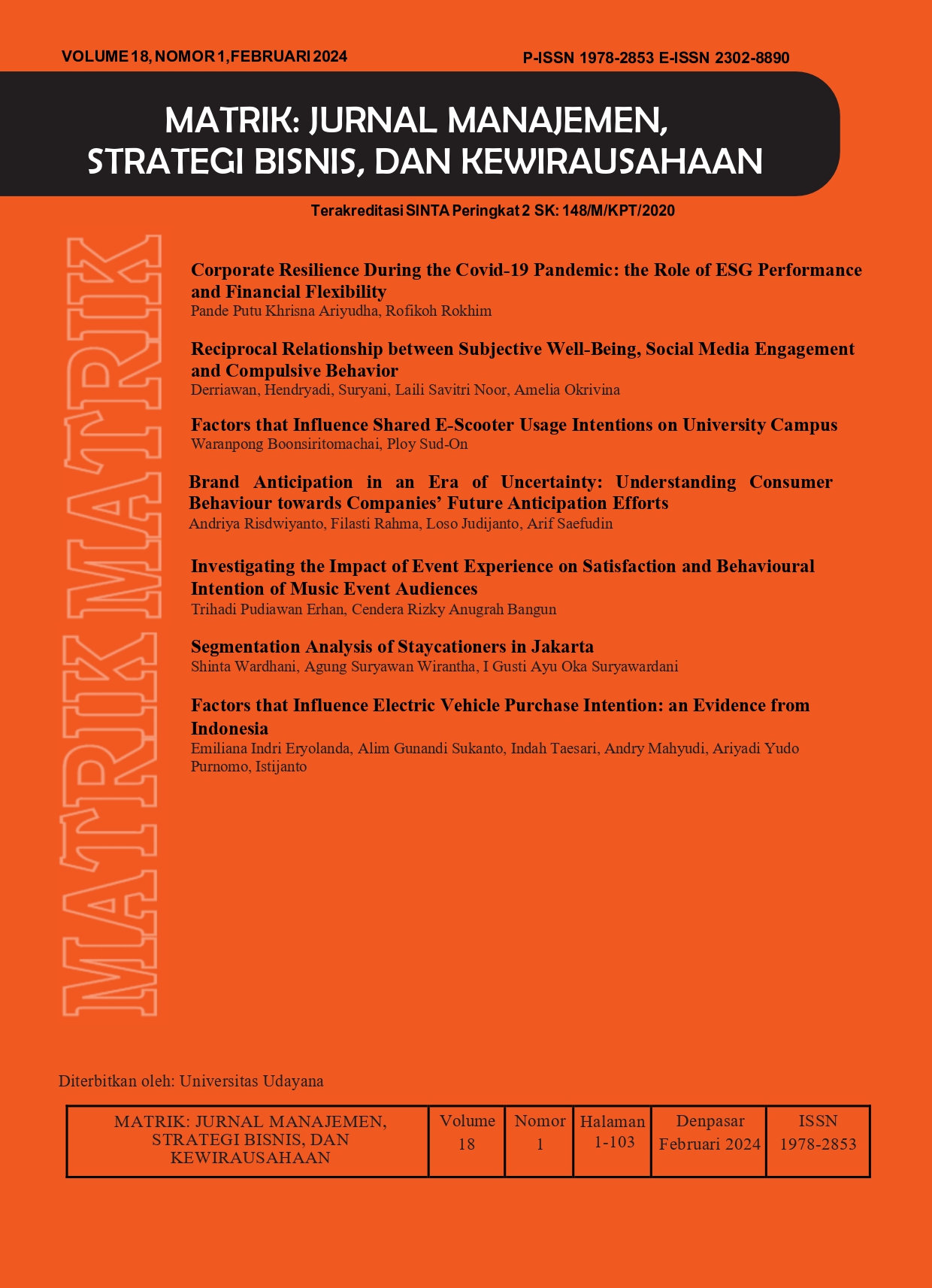Factors that Influence Electric Vehicle Purchase Intention: an Evidence from Indonesia
Abstract
Electric vehicles (EV) are new products that will replace conventional vehicles. Previous studies on factors influencing EVs purchase intention rarely includes the impact of social media factors. This study aims to build a comprehensive model examining factors that influence consumer intention to purchase EVs. Based on the theory of reasoned action and risk-benefit model, this study incorporates social media relevance, vendor trustworthiness, vendor expertise, social influence, and perceptions of EV benefits and risks. Data is collected through online surveys. 295 data were obtained and analyzed by exploratory factor analysis and multiple regression using SPSS. The results show that perceived relevance to social media has the greatest influence on EV purchase intention, followed by perceived benefits and risks, social influence, and vendor expertise, while vendor trustworthiness didn’t have a significant impact. This study’s result contributes to the knowledge of EV buying factors and offers managerial implications for EV providers’ business strategy.
Keyword: factor, purchase intention, social media, theory of reasoned action, electric vehicle
Downloads
References
Abzari, M., Ghassemi, R. A., & Vosta, L. N. (2014). Analysing the effect of social media on brand attitude and purchase intention: the case of Iran Khodro Company. Procedia - Social and Behavioral Sciences, 143, 822–826. https://doi.org/10.1016/j.sbspro.2014.07.483
AFS. (2022). Exploring Indonesian culture. https://www.afsusa.org/countries/indonesia/#afs-nav-food
AHK Indonesien. (2021, December 1). Indonesian electric vehicles industry development gains momentum. https://indonesien.ahk.de/en/infocenter/news/news-details/indonesian-electric-vehicles-industry-development-gains-momentum
Alalwan, A. A. (2018). Investigating the impact of social media advertising features on customer purchase intention. International Journal of Information Management, 42, 65–77. https://doi.org/10.1016/j.ijinfomgt.2018.06.001
Bannister, A., Kiefer, J., & Nellums, J. (2013). College students’ perceptions of and behaviors regarding Facebook© advertising: an exploratory study. The Catalyst, 3(1). https://doi.org/10.18785/cat.0301.02
Bearden, W. O., & Rose, R. L. (1990). Attention to social comparison information: an individual difference factor affecting consumer conformity. Journal of Consumer Research, 16(4), 461–471. http://jcr.wisc.edu/
Bhukya, R., & Singh, S. (2015). The effect of perceived risk dimensions on purchase intention. American Journal of Business, 30(4), 218–230. https://doi.org/10.1108/ajb-10-2014-0055
Bhutto, M. H., Tariq, B., Azhar, S., Ahmed, K., Khuwaja, F. M., & Han, H. (2022). Predicting consumer purchase intention toward hybrid vehicles: testing the moderating role of price sensitivity. European Business Review, 34(1), 62–84. https://doi.org/10.1108/EBR-10-2019-0274
Bruhn, C. M. (2007). Enhancing consumer acceptance of new processing technologies. Innovative Food Science and Emerging Technologies, 8(4), 555–558. https://doi.org/10.1016/j.ifset.2007.04.006
Bughin, J., Doogan, J., & Vetvik, O. J. (2010, April 1). A new way to measure word-of-mouth marketing. https://www.mckinsey.com/capabilities/growth-marketing-and-sales/our-insights/a-new-way-to-measure-word-of-mouth-marketing#/
Dowling, G. R. (1986). Perceived risk: the concept and its measurement. Psychology & Marketing, 3, 193–210.
Duffett, R. G. (2015). Facebook advertising’s influence on intention-to-purchase and purchase amongst millennials. Internet Research, 25(4), 498–526. https://doi.org/10.1108/IntR-01-2014-0020
Featherman, M., Jia, S. (Jasper), Califf, C. B., & Hajli, N. (2021). The impact of new technologies on consumers beliefs: Reducing the perceived risks of electric vehicle adoption. Technological Forecasting and Social Change, 169. https://doi.org/10.1016/j.techfore.2021.120847
Featherman, M. S., & Hajli, N. (2016). Self-service technologies and e-services risks in social commerce era. Journal of Business Ethics, 139(2), 251–269. https://doi.org/10.1007/s10551-015-2614-4
Featherman, M. S., Miyazaki, A. D., & Sprott, D. E. (2010). Reducing online privacy risk to facilitate e-service adoption: The influence of perceived ease of use and corporate credibility. Journal of Services Marketing, 24(3), 219–229. https://doi.org/10.1108/08876041011040622
Febransyah, A. (2021). Predicting purchase intention towards battery electric vehicles: A case of indonesian market. World Electric Vehicle Journal, 12(4). https://doi.org/10.3390/wevj12040240
Fishbein, M., & Ajzen, I. (1975). Belief, attitude, intention and behavior : an introduction to theory and research. Addison-Wesley. https://people.umass.edu/aizen/f&a1975.html
Forsythe, S., Liu, C., Shannon, D., & Gardner, L. C. (2006). Development of a scale to measure the perceived benefits and risks of online shopping. Journal of Interactive Marketing, 20(2), 55–75. https://doi.org/10.1002/dir.20061
Gefen, D. (2002). Reflections on the dimensions of trust and trustworthiness among online consumers. Database for Advances in Information Systems, 33(3), 38–53. https://doi.org/10.1145/569905.569910
Gunawan, D. D., & Huarng, K.-H. (2015). Viral effects of social network and media on consumers’ purchase intention. Journal of Business Research, 68(11), 2237–2241. https://doi.org/10.1016/j.jbusres.2015.06.004
Gunawan, H. (2022, April 21). Kemenhub: jumlah penggunaan kendaraan listrik di Indonesia sudah mencapai 17 ribu unit. https://www.tribunnews.com/bisnis/2022/04/21/kemenhub-jumlah-penggunaan-kendaraan-listrik-di-indonesia-sudah-mencapai-17-ribu-unit
Indonesian Ministry of Finance. (2015, April 29). Penghasilan kelas menengah naik = potensi pajak? https://bppk.kemenkeu.go.id/pusdiklat-pajak/berita/penghasilan-kelas-menengah-naik-potensi-pajak-922473
Jarrett, C. (2017, April 13). Different nationalities really have different personalities. https://www.bbc.com/future/article/20170413-different-nationalities-really-have-different-personalities
Kim, D. J., Ferrin, D. L., & Rao, H. R. (2008). A trust-based consumer decision-making model in electronic commerce: The role of trust, perceived risk, and their antecedents. Decision Support Systems, 44(2), 544–564. https://doi.org/10.1016/j.dss.2007.07.001
Lafferty, B. A., Goldsmith, R. E., & Newell, S. J. (2002). The dual credibility model: the influence of corporate and endorser credibility on attitudes and purchase intentions. Journal of Marketing Theory and Practice, 10(3), 1–12.
Lai, P. (2017). The literature review of technology adoption models and theories for the novelty technology. Journal of Information Systems and Technology Management, 14(1), 21–38. https://doi.org/10.4301/S1807-17752017000100002
Laura Yale, E. J., & Gilly, M. C. (1995). Dyadic perceptions information search in personal source. Journal of Business Research, 32, 225–237. https://doi.org/10.1016/0148-2963(94)00048-J
Lien, C. H., Wen, M. J., Huang, L. C., & Wu, K. L. (2015). Online hotel booking: The effects of brand image, price, trust and value on purchase intentions. Asia Pacific Management Review, 20(4), 210–218. https://doi.org/10.1016/j.apmrv.2015.03.005
Madden, T. J., Ellen, P. S., Ajzen, I. (1992). A comparison of the theory of planned behavior and the theory of reasoned action. Personality and Social Psychology Bulletin, 18(1):3-9. https://doi.org/10.1177/0146167292181001
Miranda, J. L., & Delgado, C. J. M. (2020). Determinants of electric car purchase intention in Portugal. Developments in Corporate Governance and Responsibility, 15, 161–172. https://doi.org/10.1108/S2043-052320200000015009
Mitra, K., Reiss, M. C., & Capella, L. M. (1999). An examination of perceived risk, information search and behavioral intentions in search, experience and credence services. The Journal of Services Marketing, 13(3), 208–228. https://doi.org/10.1108/08876049910273763
Newell, S. J., & Goldsmith, R. E. (2001). The development of a scale to measure perceived corporate credibility. Journal of Business Research, 52, 235–247.
Nguyen, H. T., & Chaudhuri, M. (2018). Making new products go viral and succeed. International Journal of Research in Marketing, 36(1), 39–62. https://doi.org/10.1016/j.ijresmar.2018.09.007
Ohanian, R. (1990). Construction and validation of a scale to measure celebrity endorsers’ perceived expertise, trustworthiness, and attractiveness. Journal of Advertising, 19(3), 39–52. https://doi.org/10.1080/00913367.1990.10673191
Pavlou, P. A., & Stewart, D. W. (2000). Measuring the effects and effectiveness of interactive advertising: a research agenda. Journal of Interactive Advertising, 1(1), 62–78. http://ssrn.com/abstract=2380734https://ssrn.com/abstract=2380734
Porter, C. E., & Donthu, N. (2006). Using the technology acceptance model to explain how attitudes determine internet usage: the role of perceived access barriers and demographics. Journal of Business Research, 59(9), 999–1007. https://doi.org/10.1016/j.jbusres.2006.06.003
Ram, S., & Sheth, J. N. (1989). Consumer resistance to innovations: the marketing problem and its solutions. The Journal of Consumer Marketing, 6(2), 5–14.
Schuitema, G., Anable, J., Skippon, S., & Kinnear, N. (2013). The role of instrumental, hedonic and symbolic attributes in the intention to adopt electric vehicles. Transportation Research Part A: Policy and Practice, 48, 39–49. https://doi.org/10.1016/j.tra.2012.10.004
Shofa, J. N. (2022, March 17). Roadblocks to Indonesia’s EV adoption. https://jakartaglobe.id/business/roadblocks-to-indonesias-ev-adoption
Sweeney, J. C., Soutar, G. N., Cowan, E., & Johnson, L. W. (1999). The role of perceived risk in the quality-value relationship: a study in a retail environment. Journal of Retailing, 75(1), 77–105.
Taherdoost, H. (2018). A review of technology acceptance and adoption models and theories. Procedia Manufacturing, 22, 960–967. https://doi.org/10.1016/j.promfg.2018.03.137
The Cultural Atlas. (2022). Indonesian Culture. https://culturalatlas.sbs.com.au/indonesian-culture/indonesian-culture-core-concepts
Utami, M. W. Dela, Yuniaristanto, Y., & Sutopo, W. (2020). Adoption intention model of electric vehicle in Indonesia. Jurnal Optimasi Sistem Industri, 19(1), 70–81. https://doi.org/10.25077/josi.v19.n1.p70-81.2020
Watkins, C. E., Tipton, R. M., Maims, M., & Hunton-Shoup, J. (1991). Role relevance and role engagement in contemporary school psychology. Professional Psychology: Research and Practice, 22(4), 328–332.
Xue, J., Liang, X., Xie, T., & Wang, H. (2020). See now, act now: how to interact with customers to enhance social commerce engagement? Information and Management, 57(6). https://doi.org/10.1016/j.im.2020.103324
Zeng, F., Huang, L., & Dou, W. (2009). Social factors in user perceptions and responses to advertising in online social networking communities. Journal of Interactive Advertising, 10(1), 1–13. https://doi.org/10.1080/15252019.2009.10722159
Zhu, Y. Q., & Chang, J. H. (2016). The key role of relevance in personalized advertisement: examining its impact on perceptions of privacy invasion, self-awareness, and continuous use intentions. Computers in Human Behavior, 65, 442–447. https://doi.org/10.1016/j.chb.2016.08.048
 This work is licensed under a Creative Commons Attribution-ShareAlike 4.0 International License.
This work is licensed under a Creative Commons Attribution-ShareAlike 4.0 International License.

















